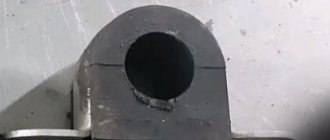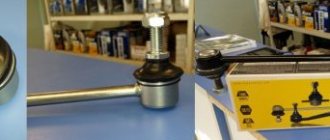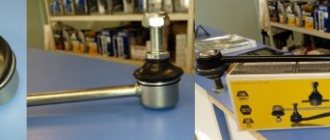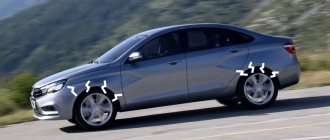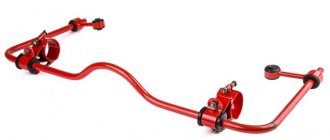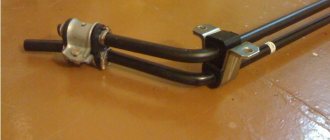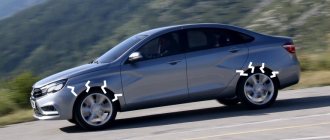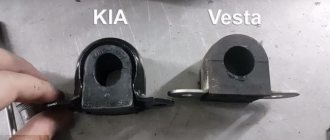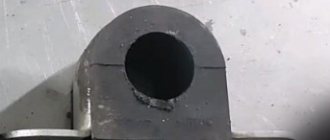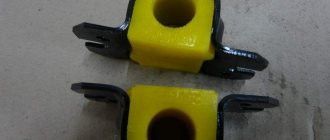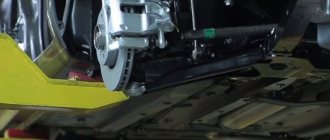The main stages of replacing stabilizer bushings:
- We place the car within the perimeter of the repair area and raise it with a hydraulic lift.
- Remove the front wheels.
- Unscrew the upper and lower fastenings of the stabilizer strut (bone).
- Unscrew the bolts and remove the left seal.
- We unscrew the five bolts (at “10”), slide the protective cover of the steering rack, and remove the right one.
- We install new rubber (polyurethane) bushings.
- We assemble the structure in reverse order.
Resource for replacing rubber seals of the front stabilizer
It is difficult to answer unequivocally how much seals cost in each specific case.
The manufacturer indicates an average replacement interval of 60 - 80 thousand km.
The interval varies depending on a number of factors:
- quality of the road surface;
- speed limits;
- driving style;
- quality of spare parts;
- temperature conditions.
Replacing stabilizer bushings on Lada Vesta
Necessary tools, materials:
- Torx wrench with set of sockets;
- ring, ring wrenches;
- knob, heads;
- Silicone based lubricant.
Sequencing:
- We hang the car with a lifting mechanism.
- We turn on the first gear to lock the front wheel drive.
- Unscrew the bolts and remove the wheels and tires one by one.
- We unscrew the nuts of the upper and lower fastening of the stabilizer (bones), use the head at “17”.
- Using a key set to “17”, release the two bolts securing the metal bracket on the torsion bar on the left side. Access to the rubber bushing is unobstructed.
- To replace the bushing, first remove the steering rack protection on the right side. Fixation of the structure with five bolts, size “10”.
- Unscrew the right bushing.
- We unscrew the two rear bolts securing the metal bracket.
- We clean the surface of the torsion bar from dirt and deposits, and lubricate it with silicone grease.
- We put on new rubber seals.
- We assemble the structure in the reverse order with a tightening torque of 1.8-2.4 kgf.m.
Self-replacement of bushings on Lada Vesta is completed.
Note to the driver! It is not necessary to make a longitudinal cut when installing seals. The presence of an incision contributes to:
- penetration of sand, dirt, moisture into the gum;
- backlash formation;
- deformation of the seal.
Selecting bushings for Lada Vesta for replacement
The best option for choosing replacement bushings is to use the brands recommended by the manufacturer. To make this choice, you need to use the vehicle's VIN code or the factory spare parts catalog. You can also select stabilizer bushings on Vesta according to the article number, it looks like this: 8450006748
Manufacturers put on the packaging of the part information about the applicability of a specific element. However, you need to take into account that this information may not be entirely specific - the factory will indicate all car models for which this spare part is suitable.
There are several criteria by which spare parts are selected:
- Manufacturer or country of origin.
- Article or catalog number.
- Applicability – machine model.
- The bushing material is rubber or polyurethane.
- Cut or uncut.
The choice in favor of one or another bushing material is completely individual. It is best to choose a specific material based on the recommendations of the car plant. Reviews from drivers who use Lada Vesta vary and the ratio is 50 x 50. Some consider polyurethane to be the best, others consider rubber.
The opinions of Lada Vesta operators also differ regarding the form in which the new bushing should be installed: cut or not. Proponents of installing cut parts rightly believe that if the part is cut, the time for its installation will be reduced by 3-4 times.
Those who believe that only the whole bushing needs to be installed pay attention to the fact that water and dirt will easily get into the part through the cut, and its “life” will be significantly reduced.
Review of Manufacturer Prices
| Name / Catalog number / Dimensions / Diameter | Price in rubles |
| Original stabilizer bushing | |
| 17012680 (inner diameter 21.5 mm) | From 400 |
| 8450006748 | From 400 |
| High-quality analogues of stabilizer bushings | |
| Polyurethane from Chevrolet Niva 2123 (17012680) | From 350 |
| Polyurethane stabilizer bushings for Lada Vesta from Kia Rio (548132K100, 548141G000) | From 550 |
| 54813-2K100 (diameter 21.5mm) | From 550 – 600 |
| KSBSOULF (diameter 21.5mm) – new sample | From 550 – 600 |
*prices are as of 03/03/2019.
Installing stabilizer bushings on Vesta from Kia
Front stabilizer bushing number 54813-2K100 (aka KSBSOULF) - 21.5mm. Cost from 150 to 500 rubles per piece.
The shape of the analogue is noticeably different from the standard bushings, so you will additionally have to buy a stabilizer bushing bracket 54814-1G000, which costs 100-500 rubles. Installation according to familiar instructions.
The cost of modification is from 500 to 2000 rubles.
In conclusion, it is worth noting that when installing analog stabilizer bushings, the characteristics of the vehicle’s suspension may change. For example, the car will not be so smooth when passing joints and uneven roads, etc.
Have you encountered a creaking noise in the front suspension of Vesta? How did you solve this problem? You can post photos of your solutions in the comments.
Almost all owners of these cars, without exception, replace the Lada Vesta stabilizer bushings. Usually, immediately after purchasing a car, the owner begins to notice a characteristic creaking of the suspension in the front end. After searching for the sources of the squeak, it turns out that the culprit is the stabilizer bar rubber. Or rather, the material from which they are made is to blame. Most likely, this is a design miscalculation or another attempt by AvtoVAZ to save money.
Recommendations for selection
Service center technicians recommend purchasing spare parts and components from certified points of sale and official representative offices in order to reduce the likelihood of purchasing counterfeits.
Carefully check the catalog numbers with the dimensions specified in the operating instructions. If you have any doubts about the quality or origin, refuse to purchase.
Conclusion
Replacing the front stabilizer bushings and rods requires careful attention on the part of the repairman. Violation of the technological process will lead to deformation of the structure.
What type of sealing sleeve to purchase is up to the owner to decide on his own, but motorists recommend polyurethane ones. Their service life is 4 times longer than rubber ones. Polyurethane bushings retain their shape better and remain elastic regardless of the ambient temperature, which ensures a high level of controllability of the technical device.
How to correctly change the Lada Vesta SPU airbags?
The technology for performing repair work on changing the rubber pads of the stabilizer bar is simple and accessible to the vast majority of motorists. Of course, if the car is under warranty, then this should be done by the mechanics of the dealer's car service center.
Preparatory activities
To carry out repair procedures, you do not even need to remove the engine protective apron. However, no one has canceled the availability of a small set of tools; for work you will need:
- Torx key T40.
- Ring wrench “16”.
- Socket wrench “13”.
- Driver, extension and 10mm socket.
- Silicone Grease.
For a comfortable and high-quality replacement of faulty stabilizer bushings on a Lada Vesta car, you need at least an inspection hole or overpass, and in the best case, a lift. Before putting the car in for repairs, it is worth washing it thoroughly, especially in the area where the work is being carried out.
Technology system
It is important to remember one important detail - you need to start changing the SPU rubber cushion only when the stabilization bar is in a relaxed state. This happens when the front wheels are suspended or the entire mass of the car is loaded evenly on an overpass or pit. After this condition is met, the process proceeds according to the following scheme:
- Using a wrench, an extension and a 10mm socket, unscrew the five bolts securing the steering gear protective cover.
- Unscrew the two rear bolts securing the mounting brackets for the cushion and the rod using a 13mm spanner.
- Using a Torx T40 ratchet wrench, unscrew the two front bolts on the brackets (on the steering rack side).
- Dismantle the bracket and remove the old bushings.
- Make a cut in the bottom of the new cushions.
- Treat the inner surface of the holes in the pads with silicone grease and put them on the bar.
- Tighten the fastening nuts in the reverse order, tightening torque – 1.8-2.4 kgf.m.
Judging by the reviews of “vestavods”, the service life of polyurethane products is 3-4 times higher than that of rubber ones. Such pillows retain elasticity and resilience even at low temperatures, which guarantees the stability of the car, as well as a high level of its handling.
Almost all owners of these cars, without exception, replace the Lada Vesta stabilizer bushings. Usually, immediately after purchasing a car, the owner begins to notice a characteristic creaking of the suspension in the front end. After searching for the sources of the squeak, it turns out that the culprit is the stabilizer bar rubber. Or rather, the material from which they are made is to blame. Most likely, this is a design miscalculation or another attempt by AvtoVAZ to save money.
Reviews
| № | Positive |
| 1. | Petrovich , 35 years old (drive2.ru) Sverdlovsk: the car is a year old, I drive on the original bushings, no knocks, no rattles. I hope that they will last another 40 - 50 thousand km. |
| 2. | Vasily , 43 years old (prom.ua), Krasnodar: drove Vesta for two winters, original parts. There are no comments, the right side knocks a little, I blame the weak tightening of the rack. |
| 3. | Gennady , 38 years old (autotoday.com), Omsk: I won’t say that the quality of the original seals is super, but I’ve been driving for the third season and there’s no knocking. The manufacturer gives a guarantee of 60,000 km, let's see how long it lasts. |
| 4. | Vasily Gavrilovich , 48 years old (rozetka.ua), Rostov-on-Don: drove 45,000 km, a knock appeared on the right side. I went to the service station for diagnostics, the master said that the stabilizer bushings needed to be changed. |
| 5. | Dmitry Petrovich , 43 years old, Kursk (avtoflit.com): I bought the car second-hand, got it in good condition, well-kept. The speedometer shows 50,000 km, diagnostics showed good results. |
| 6. | Alexander Petrovich , 33 years old, Voronezh (autotoday.com): I’ve heard a lot of negativity about the quality of the seals, I can’t confirm it, since I’ve already driven 65,000 km on the factory ones. |
| Negative | |
| 7. | Vladimir , 38 years old (prom.ua), Uralsk: the speedometer already has 45,000 km, and the rubber bands on the stabilizers already need to be changed. Worn out very quickly, poor quality. It's better to buy from Kia, Toyota. |
| 8. | Mikhailovich , 44 years old, Moscow (avtoflit.com): I drove the originals for two winters, but it didn’t last longer. I heard that spare parts from Kia and Toyota are compatible. You need to get advice and install it at a service station. |
| 9. | Vladlen , 34 years old, Voronezh (drive2.ru): dissatisfied with the quality of production of the original bushings, they have already flown 45,000 km. I will buy foreign analogues, since the quality there is much better. |
| 10. | Mikhail Petrovich , 35 years old, Pskov (autotoday.com): on my first car Lada Granta, the spare parts took longer to take care of, why this is the case with the Lada Vesta, I don’t know. I think the reason is the quality of domestic components. |
